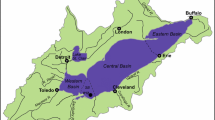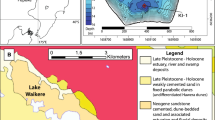Abstract
We used seven annually laminated (varved) sediment cores from Nylandssjön, a lake in northern Sweden, to assess between-core variation and diagenetic changes at annual resolution. By using several cores, multiple elements and employing principal components analysis (PCA), we also studied how the geochemical composition changed over time, and assessed to what extent these changes were related to variations in the weather. There are between-core differences for aluminum, silica, lead, titanium, zirconium and dry-mass accumulation rate. Diagenesis causes a decrease in bromine, as well as carbon, nitrogen and varve thickness, as reported in previous publications. In spite of anoxic bottom waters phosphorus is not lost from the sediment. In fact, there is an increase in phosphorus concentrations with time. The PCA identified four principal components (PCs). PC-1 accounts for the relative content of mineral and organic material; PC-2 represents mineral-particle grain size; PC-3 reflects phosphorus loading and PC-4 reflects atmospheric pollution. Variations in the weather partly explain the temporal patterns in PC-1 and PC-2: cold winters, i.e. more accumulation of snow, resulted in more mineral than organic matter (i.e. higher PC-1 scores), and increased the relative amount of coarse-grained mineral particles in the sediment (i.e. lower PC-2 scores). Increased spring precipitation had a weak positive effect on the PC-2 scores by promoting the transport of fine-grained material. However, the influence of weather is weak, explaining at most 30 % of the variance, and hence, other factors, e.g. land use and its effect on soil erosion, seem to be more important for the sediment geochemical composition. The importance of land use is also exemplified by an increase in PC-3 scores in the late 1970s, which can be attributed to a shift in agricultural practices that resulted in increased phosphorus loading to the lake. In summary, our findings show that down-core trends are reproducible between cores, but between-core variability and diagenesis need to be considered when interpreting some elements. We also conclude that there is a need to constrain temporal changes in land use before using lake sediments to study changes in weather or climate.







Similar content being viewed by others
References
Biester H, Keppler F, Putschew A, Martinez Cortizas A, Petri M (2004) Halogen retention, organohalogens, and the role of organic matter decomposition on halogen enrichment in two Chilean peat bogs. Environ Sci Technol 38:1984–1991
Bindler R, Renberg I, Brännvall ML, Emteryd O, El-Daoushy F (2001) A whole-basin study of sediment accumulation using stable lead isotopes and flyash particles in an acidified lake, Sweden. Limnol Oceanogr 46:178–188
Bindler R, Wik M, Renberg I (2008) Landscape-scale patterns of sediment sulfur accumulation in Swedish lakes. J Paleolimnol 39:61–70
Boës X, Rydberg J, Martinez-Cortizas A, Bindler R, Renberg I (2011) Evaluation of conservative lithogenic elements (Ti, Zr, Al, and Rb) to study anthropogenic element enrichments in lake sediments. J Paleolimnol 46:75–87
Brännvall ML, Bindler R, Renberg I, Emteryd O, Bartnicki J, Billström K (1999) The Medieval metal industry was the cradle of modern large scale atmospheric lead pollution in northern Europe. Environ Sci Technol 33:4391–4395
Cheburkin AK, Shotyk W (1996) An energy-dispersive miniprobe multielement analyzer (EMMA) for direct analysis of Pb and other trace elements in peat. Fresenius J Anal Chem 354:688–691
Cheburkin AK, Shotyk W (2005) Energy-dispersive XRF spectrometer for Ti determination (TITAN). X-Ray Spectrom 34:69–72
Cook TL, Bradley RS, Stoner JS, Francus P (2009) Five thousand years of sediment transfer in a high arctic watershed recorded in annually laminated sediments from Lower Murray Lake, Ellesmere Island, Nunavut, Canada. J Paleolimnol 41:77–94
Correll DL (1998) The role of phosphorus in the eutrophication of receiving waters: a review. J Environ Qual 27:261–266
Correll DL, Jordan TE, Weller DE (2001) Effects of precipitation, air temperature, and land use on organic carbon discharges from rhode river watersheds. Water Air Soil Pollut 128:139–159
Dawdy DR, Matalas NC (1964) Statistical and probability analysis of hydrologic data, part III: analysis of variance, covariance and time series. In: Chow VT (ed) Handbook of applied hydrology, a compendium of water-resources technology. McGraw-Hill Book Company, New York, pp 8.68–8.90
De Jong R, Kamenik C (2011) Validation of a chrysophyte stomatocyst-based cold-season climate reconstruction from high-Alpine Lake Silvaplana, Switzerland. J Quat Sci 26:268–275
Dean WE, Bradbury JP, Anderson RY, Barnosky CW (1984) The variability of Holocene climate change—evidence from varved lake-sediments. Science 226:1191–1194
Deer WA, Howie RA, Zussman J (1992) An introduction to the rock-forming minerals. Longman Scientific & Technical, Harlow
Einsele W (1936) Uber die Beziehungen des Eisenkreislaufs zum Phosphatkreislauf in eutrophen See. Arch Hydrobiol 29:664–686
Elbert J, Grosjean M, von Gunten L, Urrutia R, Fischer D, Wartenburger R, Ariztegui D, Fujak M, Hamann Y (2012) Quantitative high-resolution winter (JJA) precipitation reconstruction from varved sediments of Lago Plomo 47° S, Patagonian Andes, AD 1530–2002. Holocene 22:465–474
Fritz SC (2008) Deciphering climatic history from lake sediments. J Paleolimnol 39:5–16
Gajewski K, Hamilton PB, McNeely R (1997) A high resolution proxy-climate record from an arctic lake with annually-laminated sediments on Devon Island, Nunavut, Canada. J Paleolimnol 17:215–225
Gälman V, Petterson G, Renberg I (2006) A comparison of sediment varves (1950–2003 AD) in two adjacent lakes in northern Sweden. J Paleolimnol 35:837–853
Gälman V, Rydberg J, Sjöstedt de-Luna S, Bindler R, Renberg I (2008) Carbon and nitrogen loss rates during ageing of lake sediment: changes over 27 years studied in a varved lake sediment. Limnol Oceanogr 53:1076–1082
Gälman V, Rydberg J, Bigler C (2009a) Decadal diagenetic effects on d13C and d15N studied in varved lake sediment. Limnol Oceanogr 54:917–924
Gälman V, Rydberg J, Shchukarev A, Sjöberg S, Martinez-Cortizas A, Bindler R, Renberg I (2009b) The role of iron and sulfur in the visual appearance of lake sediment varves. J Paleolimnol 42:141–153
Guo TZ, DeLaune RD, Patrick WH (1997) The influence of sediment redox chemistry on chemically active forms of arsenic, cadmium, chromium, and zinc in estuarine sediment. Environ Int 23:305–316
Håkanson L, Jansson M (1983) Principals of lake sedimentology. Springer, Berlin, p 316
Hodell DA, Schelske CL (1998) Production, sedimentation, and isotopic composition of organic matter in Lake Ontario. Limnol Oceanogr 43:200–214
Hubeny JB, King JW, Reddin M (2011) Northeast US precipitation variability and North American climate teleconnections interpreted from late Holocene varved sediments. Proc Natl Acad Sci USA 108:17895–17900
Hupfer M, Lewandowski J (2008) Oxygen controls the phosphorus release from lake sediments—a long-lasting paradigm in limnology. Int Rev Hydrobiol 93:415–432
Kaiser HF (1958) The varimax criterion for analytic rotation in factor-analysis. Psychometrika 23:187–200
Koinig KA, Shotyk W, Lotter AF, Ohlendorf C, Sturm M (2003) 9000 years of geochemical evolution of lithogenic major and trace elements in the sediment of an alpine lake—the role of climate, vegetation, and land-use history. J Paleolimnol 30:307–320
Lehmann MF, Bernasconi SM, Barbieri A, McKenzie JA (2002) Preservation of organic matter and alteration of its carbon and nitrogen isotope composition during simulated and in situ early sedimentary diagenesis. Geochim Cosmochim Acta 66:3573–3584
Lockhart WL, Macdonald RW, Outridge PM, Wilkinson P, DeLaronde JB, Rudd JWM (2000) Tests of the fidelity of lake sediment core records of mercury deposition to known histories of mercury contamination. Sci Total Environ 260:171–180
Lotter AF, Birks HJB (1997) The separation of the influence of nutrients and climate on the varve time-series of Baldeggersee, Switzerland. Aquat Sci 59:362–375
Maier DB, Rydberg J, Bigler C, Renberg I (2013) Compaction of recent varved lake sediments. GFF 135:231–236
Moore JJ, Hughen KA, Miller GH, Overpeck JT (2001) Little ice age recorded in summer temperature reconstruction from vared sediments of Donard Lake, Baffin Island, Canada. J Paleolimnol 25:503–517
Mortimer CH (1941) The exchange of dissolved substances between mud and water in lakes II. J Ecol 30:147–201
Park SS, Jaffe PR (1996) Development of a sediment redox potential model for the assessment of postdepositional metal mobility. Ecol Model 91:169–181
Perry KA, Pedersen TF (1993) Sulfur speciation and pyrite formation in meromictic ex-fjords. Geochim Cosmochim Acta 57:4405–4418
Petterson G, Renberg I, Geladi P, Lindberg A, Lindgren F (1993) Spatial uniformity of sediment accumulation in varved lake sediments in northern Sweden. J Paleolimnol 9:195–208
Petterson G, Renberg I, Sjöstedt de-Luna S, Carlén P-O, Anderson NJ (2010) Climate forcing and inter-annual variability of late-Holocene sediment supply in a boreal forest catchment. Earth Surf Proc Land 35:390–399
Renberg I (1981) Formation, structure and visual appearance of iron-rich, varved lake sediments. Verh Int Ver Theor Angew Limnol 21:94–101
Renberg I (1986) Photographic demonstration of the annual nature of a varve type common in N Swedish lake-sediments. Hydrobiologia 140:93–95
Romero-Viana L, Julia R, Camacho A, Vicente E, Miracle MR (2008) Climate signal in varve thickness: lake La Cruz (Spain), a case study. J Paleolimnol 40:703–714
Rydberg J, Gälman V, Renberg I, Lambertsson L, Martinez Cortizas A, Bindler R (2008) Assessing the stability of mercury and methylmercury in a varved lake sediment deposit. Environ Sci Technol 42:4391–4396
Rydberg J, Rosén P, Lambertsson L, De Vleeschouwer F, Tomasdotter S, Bindler R (2012) Assessment of the spatial distributions of total- and methyl-mercury and their relationship to sediment geochemistry from a whole-lake perspective. J Geophys Res Biogeosci 117:G04005
Shchukarev A, Gälman V, Rydberg J, Sjöberg S, Renberg I (2008) Speciation of iron and sulphur in seasonal layers of varved lake sediments: an XPS study. Surf Interface Anal 40:354–357
Stone M, Droppo IG (1996) Distribution of lead, copper and zinc in size-fractionated river bed sediment in two agricultural catchments of southern Ontario, Canada. Environ Pollut 93:353–362
Taboada T, Cortizas AM, Garcia C, Garcia-Rodeja E (2006) Particle-size fractionation of titanium and zirconium during weathering and pedogenesis of granitic rocks in NW Spain. Geoderma 131:218–236
Tian JA, Nelson DM, Hu FS (2011) How well do sediment indicators record past climate? An evaluation using annually laminated sediments. J Paleolimnol 45:73–84
Tokarz JA, Ahn MY, Leng J, Filley TR, Nies L (2008) Reductive debromination of polybrominated diphenyl ethers in anaerobic sediment and a biomimetic system. Environ Sci Technol 42:1157–1164
Visbeck MH, Hurrell JW, Polvani L, Cullen HM (2001) The North Atlantic Oscillation: past, present, and future. Proc Natl Acad Sci USA 98:12876–12877
von Gunten L, Grosjean M, Kamenik C, Fujak M, Urrutia R (2012) Calibrating biogeochemical and physical climate proxies from non-varved lake sediments with meteorological data: methods and case studies. J Paleolimnol 47:583–600
Yang HD, Rose NL, Battarbee RW, Monteith D (2002) Trace metal distribution in the sediments of the whole lake basin for Lochnagar, Scotland: a palaeolimnological assessment. Hydrobiologia 479:51–61
Acknowledgments
We thank all people who were involved in sampling at Nylandssjön over the years, especially Professor Ingemar Renberg. We also thank Manuela Costa Casais who performed the ED-XRF analysis at the RIAIDT facilities at University of Santiago de Compostela (Spain). Financial support was provided by the Swedish Research Council and the Faculty of Science and Technology at Umeå University.
Author information
Authors and Affiliations
Corresponding author
Electronic supplementary material
Below is the link to the electronic supplementary material.
Rights and permissions
About this article
Cite this article
Rydberg, J., Martinez-Cortizas, A. Geochemical assessment of an annually laminated lake sediment record from northern Sweden: a multi-core, multi-element approach. J Paleolimnol 51, 499–514 (2014). https://doi.org/10.1007/s10933-014-9770-x
Received:
Accepted:
Published:
Issue Date:
DOI: https://doi.org/10.1007/s10933-014-9770-x




